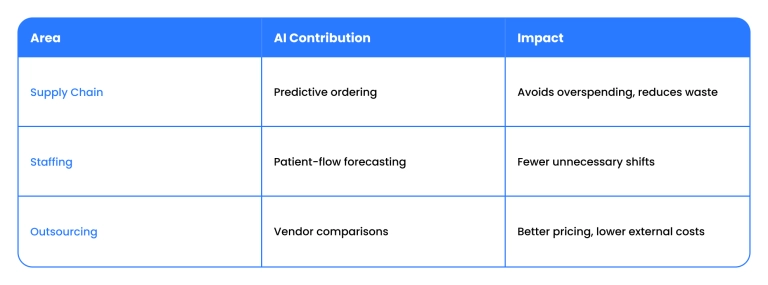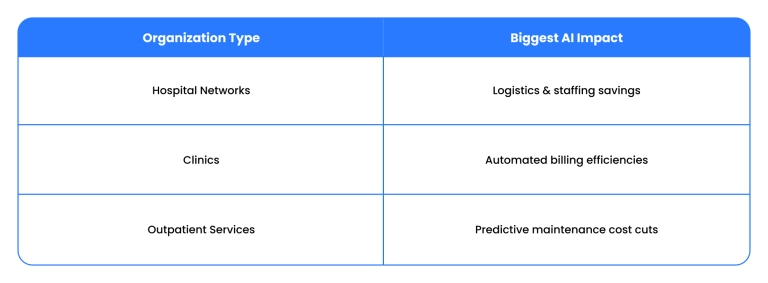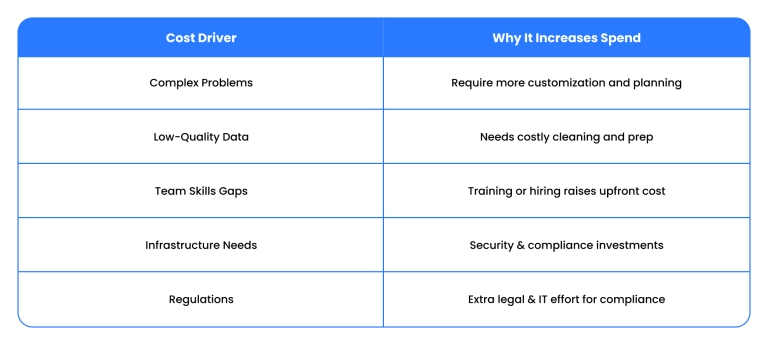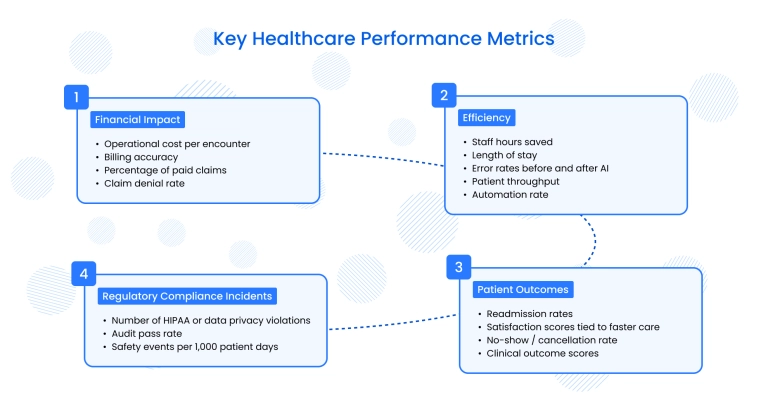Healthcare organizations can save 25%-30% of admin costs with AI. Still, many leaders hesitate, unsure how to keep expenses down and see real, lasting ROI .
If you're juggling stretched budgets, tricky workflows, and high-stakes decisions, healthcare AI offers immediate and practical relief.
Skip the guesswork. Here, you'll find how intelligent automation, practical rollout, and clear benchmarks turn AI into a financial win. With case studies and tips to tackle common roadblocks, this article lets you deliver real savings – whether you run a hospital, clinic, or outpatient service.
You'll learn:
- Top ways AI slashes costs across healthcare
- Practical steps for a smooth, low-risk rollout
- How to upskill staff and connect old systems with new tools
- Measuring results and keeping value without risking compliance or equity
AI applications for reducing healthcare costs
If you manage budgets and patient care, getting costs under control can feel impossible. Maybe you're losing sleep over rising AI expenses, or questioning if you'll ever see true ROI. You're not alone. We work with teams who face these worries every day – here's how AI tackles cost reduction head-on.
How AI helps providers save money
AI is more than just diagnosis tech or patient records. It's a real tool for cutting costs behind the scenes. Whether it's predictive analytics that spot waste or automation clearing out bureaucratic clutter, healthcare organizations use AI to streamline supply orders, fine-tune staffing, and avoid expensive outsourcing.

Financial operations: Making your dollars work smarter
AI-driven billing and revenue cycle management make payments faster and more accurate as automation slashes manual errors.
AI finds patterns in payment delays and denials. This means more claims paid, less lost revenue, and your front desk team finally gets their evenings back.
Cost savings by sector
Savings differ by organization:

Thinking about AI for your team? Contact Binariks – a quick chat can help you get on the path to relief and growth.
Streamlining workflows and administrative burdens
You want your staff focused on patient care, not drowning in paperwork or outdated tech. We get it: manual tasks waste time and money. Let's show you how intelligent automation pushes your team forward.
AI automation: Less admin, more care
Plain and simple: routine tasks like billing, claims, and scheduling shouldn't slow you down.
AI can handle repetitive work faster, with fewer slip-ups. Picture software ticking off checklists, managing approvals, and sorting information, so your people spend more time with patients.
Improving electronic health records
EHR shouldn't drag your team down. AI tools can automate data entry, flag missing info, and organize charts using natural language processing . Less time spent wrestling with software means more time spent on patient care.
If your organization faces EHR backlog or errors, AI can clean up files, predict missing information, and speed up chart reviews. That's how real cost savings happen.
Serving patients faster with AI
Patients want answers quickly and easy experiences. AI boosts your operations .
- Smart scheduling matches appointments to patient needs.
- Virtual assistants guide patients through insurance steps.
- AI chatbots handle routine front desk questions, confirm appointments, and manage pre-visit paperwork.
This streamlines your work and gives patients faster service and clear communication.
Transform healthcare with Binariks' proven AI consulting and development services
Making AI happen: Strategies and roadblocks
AI can deliver big wins only if you roll it out thoughtfully. Starting out can feel stressful – where do you begin, how do you manage costs, and how can you keep your team calm through the changes?
Phased rollout: Step-by-step success
Don't jump in all at once. Roll out AI in phases:
- Pick one or two high-impact projects first (say, automating paperwork or supporting diagnostics).
- Track results, get feedback, and improve before moving to the next step.
- Use early wins to build buy-in and set a solid foundation.
Breaking things down saves money, avoids setbacks, and builds momentum at a steady pace.
Using existing tools and outsourcing
You don't have to build from scratch to make a difference.
- Spot proven platforms already built for healthcare.
- Outsource complex AI tasks to experienced vendors, saving time and overhead.
- This keeps your budget safe and lets you focus on bigger goals.
Tapping into ready-made solutions or outside help brings fast results without risky, costly starts.
What drives AI costs up?
We won't sugarcoat it: uncontrolled AI spending is a real risk, but you can plan ahead.

Leading change: Building team buy-in
Technical fixes aren't enough. Trust and communication matter.
- Set meaningful goals, and show staff how AI helps them – not threatens their jobs.
- Create open channels for questions and feedback.
- Share wins often.
People support change when they see real benefits and feel heard.
Upskilling: Investing in your team
Tech is only as good as the people using it.
- Offer practical workshops for new AI tools.
- Pair veterans with tech specialists for hands-on training.
- Support ongoing, bite-sized learning.
If the thought of upskilling feels overwhelming, our agency builds training programs to boost confidence and abilities, so your team leads the way.
Connecting AI to legacy systems
Healthcare often depends on legacy systems . Upgrading doesn't have to mean ripping everything out.
- Map data flows to spot easy fixes, such as linking scheduling platforms to records databases.
- Use connectors and APIs to bridge gaps.
- Give your IT team the time and training they need.
Smooth integrations keep costs down and help you get the most value from new AI while maintaining the strengths of existing workflows.
Bringing AI into healthcare isn't a cookie-cutter process. Binariks supports you with planning, risk reduction, team augmentation, and a transparent step-by-step approach focused on your unique needs.
Measuring and maximizing ROI: Make your AI work pay off
AI in healthcare can be a significant change, but how do you know it's worth the money? You may have started automating, using predictive analytics, or revamping operations – but is it saving money, and will those improvements last? We help organizations move past "hype" and focus on clear results.
How to monitor ROI and build long-term value
Simple ROI isn't just a math problem – it's about smoother workflows, better care, and less stress. Here's how we help healthcare organizations track visible savings and long-term gains.
Steps for success:
- Track total costs over time: Look beyond the initial investment. Monitor ongoing maintenance, training, and upgrades. Are you freeing up staff for more important duties?
- Estimate payoff periods: Map out how quickly savings cover your upfront costs.
- Assess staff and patient outcomes: Fewer headaches, burnout, and happier patients all build ROI beyond the dollar amount.
Pick KPIs that matter
Choose tracking metrics that reflect your goals, so you know if real cost savings are happening:
- Financial impact: Cost per patient, billing accuracy, percentage of paid claims.
- Efficiency: Staff hours saved, length of stay, error rates before and after AI.
- Patient results: Readmission rates and satisfaction scores tied to faster care.
Start small, review data every quarter, and give your team open updates. Honest feedback helps everyone move forward.

Real impact: Binariks' case study
Binariks partnered with a healthcare technology provider to develop an agentic AI platform that automated scheduled check-ins, task reminders, and documentation. This process had been draining staff time and causing workflow disruptions.
In just four weeks, our dedicated team delivered a scalable MVP built on LangChain, OpenAI GPT, FastAPI, and PostgreSQL. The results were quick and measurable:
- 30% reduction in follow-up documentation time, freeing clinicians to focus on patient care
- 2× increase in compliance rates for scheduled check-ins and reminders
- Improved documentation traceability and asynchronous workflows, reducing interruptions and stress on care teams
This project validated the power of LLM-driven agents in real-world hospital workflows and created a foundation for future expansion into broader care coordination and communication automation.
Curious about the technical details? Read the full case study to discover how our Agent-based solution transformed hospital workflows.
Handling compliance and ethics
Saving money is excellent, but never at the cost of patient privacy or fairness. You want financial results and lasting trust.
How to protect your organization:
- Audit algorithms often to spot and fix bias
- Stay on top of changing regulations ; assign dedicated staff
- Train your whole team – from IT to clinical – on AI's impact on data security
We'll be straight with you – this part takes ongoing effort. With good processes, you can lower costs, get the most from AI, and keep patient trust.
Final thoughts
AI is rapidly becoming a core driver of efficiency and better care in the healthcare sector. Beyond lowering administrative costs, it improves claim accuracy, predicts patient flow, and helps staff spend more time with patients instead of paperwork.
Providers gaining the most value treat AI as an ongoing capability, starting with targeted projects, integrating with existing systems, and continuously measuring impact. This approach delivers compounding benefits – fewer errors, faster approvals, and stronger margins – while supporting patient satisfaction.
If you want a clear, low-risk roadmap to maximize savings and outcomes, contact Binariks and turn AI into a sustainable advantage.
Share

